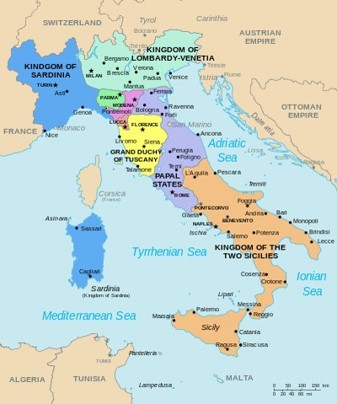
The Kingdom of Two Sicilies, now known as Southern Italy, was the largest and most populous state of the Italian peninsula. The name Kingdom of the Two Sicilies came about for the reasons explained below. For the last one thousand years, Southern Italy was ruled by various dynasties, Normans, French, Spanish, and others. As the rulers changed, often boundaries were rewritten. At one point Southern Italy was known as the Kingdom of Sicily. Then the island of Sicily seceded and kept the name of the Kingdom of Sicily. In the meantime, the ruler of the mainland decided to keep his title of King of Sicily. When the island and the mainland were finally reunited, to avoid any arguments, the new entity was renamed the Kingdom of the Two Sicilies. This happened at the beginning of the eighteenth century. The following were the independent states:
- The Kingdom of the Two Sicilies
- The Papal States
- The Republic of San Marino
- The Grand Duchy of Tuscany
- The Duchy of Modena
- The Principality of Parma
- The Lombardo Veneto (under Austrian rule)
- The Kingdom of Sardinia also known as the Kingdom of Savoy (Piedmont)
Bourbon’s Dynasty
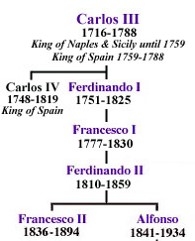
For the last 3 centuries, prior to the creation of the Kingdom of Two Sicilies, Southern Italy was ruled by Spain. In 1734 one of the Spanish Princes, Carlo di Borbone managed to convince the Spanish government to relinquish control of Southern Italy and he became the first monarch of the Neapolitan Bourbon dynasty (Borboni di Napoli) to rule over the Kingdom of the Two Sicilies. Carlo di Borbone proved to be an exceptionally enlightened and talented monarch. Under his rule architecture, arts, music, science, technology, commerce, and industry flourished and the golden period of the history of the Kingdom of the Two Sicilies began.
Carlo di Borbone only ruled until 1756 when he was offered the crown of Spain and moved to Madrid as King of Spain, but his successors carried on his legacy.
Next will show some of the remarkable accomplishments that took place under the Bourbon dynasty that can be seen as the pride of the Kingdom of the Two Sicilies.

The Kingdom had a good size army and fleet. The latter was third in size after the British and French fleet, it was a respectable one. It had important shipyards, textile industries, and commercial relationships with the rest of the world, including the United States. See The Kingdom of Two Sicilies and the USA. Despite the slander, backed by the interested British government and its Piedmontes allied, that it was a negation of God, the kingdom could show many “supremacies” and accomplishments that all the other states of the peninsula could not. This marks in a profound way the Southern civilization and society in the eighteenth and nineteenth centuries. It also shows how positive and constructive the works of the Bourbon sovereigns were and how misleading and untruthful the northern propaganda of a backward state whose people had to be freed from their bondage by their “generous brothers” coming down from the north. Elsewhere we’ll talk about the crucial role that England played, along with France, in causing the demise of the kingdom by providing diplomatic, monetary, and military support to northern Piedmont (aka Kingdom of Sardinia, aka Kingdom of Savoy). See The Kingdom of Two Sicilies and England.
The fact that these accomplishments were ignored or completely obliterated by the northern backward-thinking and greedy invaders not only was a sin in itself, but it eliminated first-class know-how and expertise giving rise to the economic and social gap between North and South that still exists today. Remember this was the beginning of the industrial revolution and the South was ahead of the game until the invasion happened.
The invaders stole billions in gold and silver, machinery from textile to shipyard, and destroyed a rising industry and related know-how and working class. Over the years the invaders and their descendants have played a dirty game. First, they stripped the South of its wealth and industrial structure resulting in mass emigration. Then they accused the inhabitants of the South of being lazy, without initiative, and living on handouts given to them by the “generous” and “industrious” North.
Industry
In 1856, at the Paris International Exhibition, the Kingdom of Two Sicilies received the prize for the third industrially developed country in the world and the first in Italy. Next, you can see some examples that represent the Kingdom of Two Sicilies’ accomplishments, many first in the Italian peninsula and some in Europe or the world. These accomplishments were ignored or completely obliterated by the northern invaders. This to the detriment not only of the South but of the nation as a whole because of the greed and short-sightedness of Piedmont’s establishment. Click on the images to get related information.
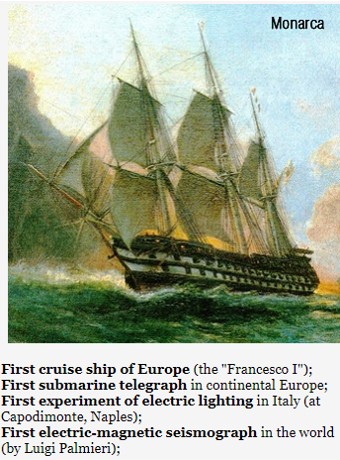 Shipyards Shipyards | 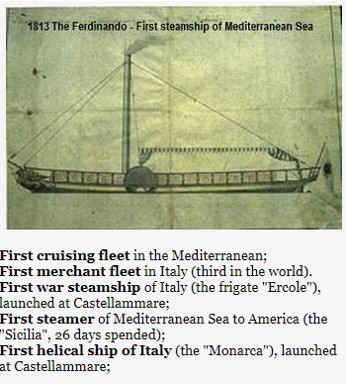 Ships Engineering Ships Engineering |
Art
The following are examples of the kingdom’s artistic accomplishments.
 |  |
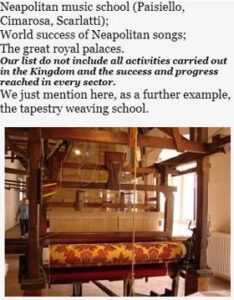 |
Science
The following are examples of the kingdom’s scientific accomplishments.
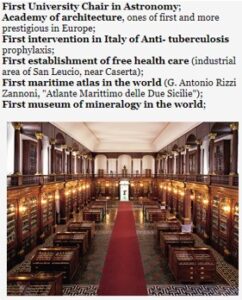 | 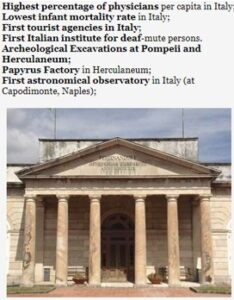 |
Economy
The following picture shows the kingdom’s economic situation compared to the other states of the peninsula including the “future liberator” Kingdom of Sardinia.
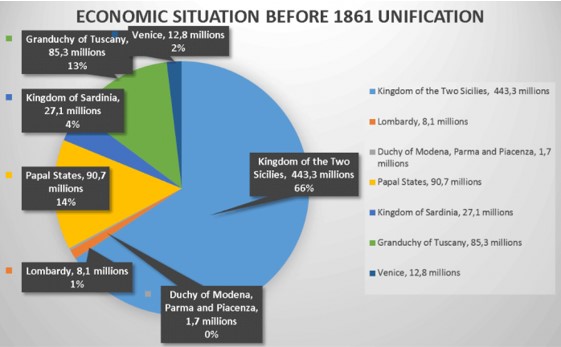
In a nutshell, the economic situation was the following
- The taxes were lower than those of other states of the peninsula.
- State property and church assets exceeded the ones of the other states.
- The public debt was small and four times lower than that of Piedmont and much lower than that of Tuscany.
- The amount of coinage in circulation was twice the one of all the other states combined.
- Francesco Nitti, prime minister of the newly formed kingdom of Italy, in his book “North and South” said that at the time of the introduction of the “lira”, the new Italian currency, from the Kingdom of Two Sicilies’ coffer was “withdrawn” 443.3 million of various coinage of which 424 million were silver coins, accounting for 66% of all circulating coins in the Italian peninsula.

Conclusions
The previous graph may give a better idea as to why the bankrupt kingdom of Sardinia wanted to “liberate the brothers of the South” from the Bourbon royal dynasty. The war was bankrolled by England (Rothschild family) who among other interests, had its eye on the sulfur mines in Sicily and wanted to prevent France from gaining a foothold in the Mediterranean Sea. Remember that this is the time of the opening of the Suez Canal and the perfidious Albion could not allow the deal to slip away from her claws. See about England’s role in the Italian “unification” here: The Kingdom of Two Sicilies and England.
Between 1860 and 1871, following the “unification”, the industry was moved north. The workforce in the South was reduced to 195,000 from 750,000; while in the North increased to 4,400,000 from 350,000. Emigration from the north to foreign countries relented and the exodus of Southern Italians to America began. The South became a colony of the North and the economic and social gap became wider and wider and never stopped.
Ask yourself these questions:
- Can you still believe in the “fairy tale” of the “Risorgimento” presenting the Kingdom of Two Sicilies as the most hated and old-fashioned in Italy?
- How do you explain that before the “unification,” the phenomenon of emigration did not exist and, in the decades following the “unification”, almost 20 million people left the South?

- Is what described a logical explanation of a decade-long civil war that took place in the South against what in actuality was an occupier northern army?

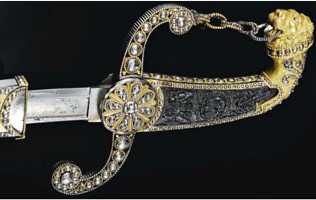 Iron factories
Iron factories Iron bridge Garigliano river
Iron bridge Garigliano river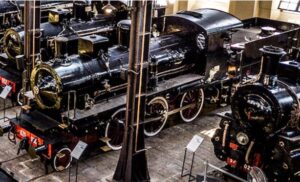 Locomotive steam engines
Locomotive steam engines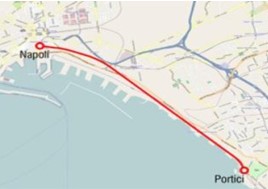 Railroad and railway stations
Railroad and railway stations